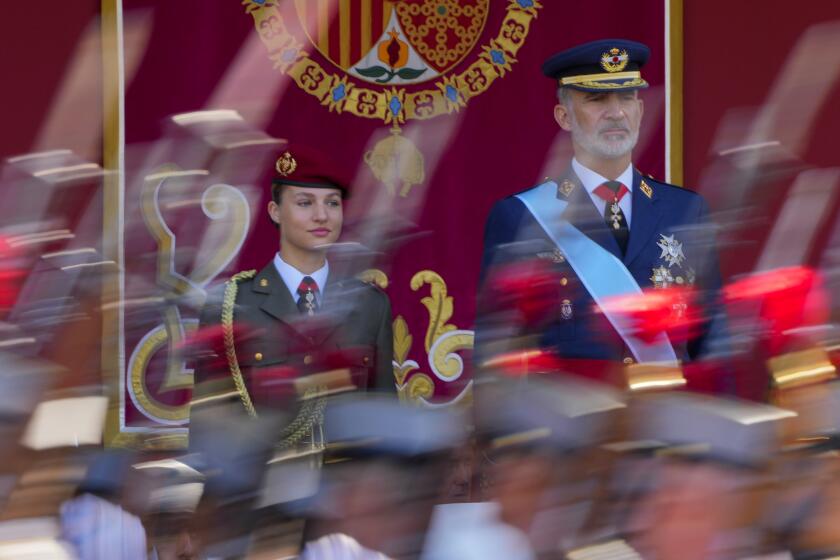For Bollywood, a rewritten script
MUMBAI, India -- When Amit Shah, a budding young actor born in Chicago, auditioned for a role in the upcoming Hollywood comedy “Fraternity House,” the directors picked him to play an Indian exchange student. He was told to wear glasses and sport a thick Indian accent like Apu, the convenience-store owner in “The Simpsons.”
The 27-year-old of Indian origin did his best. But he quickly realized that if he was going to be pigeonholed as the token Indian immigrant, he had better visit the country of his parents’ birth and attend one of the growing number of acting schools in Mumbai, a sprawling metropolis of 17 million.
But once here, he wanted to stay. Mumbai is experiencing an economic boom that is fueling its fast-evolving film industry, the world’s largest, with twice the movie output of Hollywood.
“Initially, I came here to learn the culture. I never had any intentions of staying. I don’t even speak Hindi,” Shah said at the Actor Prepares school, surrounded by others of Indian descent from the United States, Britain and Canada. “But Bollywood has so much opportunity these days. I have just fallen in love with the Indian film industry.”
More than ever before, Bollywood is being flooded with cash from Indian investors who see the country’s film industry as a money machine. The rise of the multiplex theater has led to a wider variety of films, with more socially relevant scripts that discard the overused Bollywood formula: a rambling, four-hour hodgepodge of twins separated at birth, rare blood diseases, wet sari scenes and lots and lots of singing and dancing in alpine meadows. More linear and socially conscious story lines are becoming popular, as are shorter movies.
“The new trend in Bollywood is the death of the cliche,” said Anupam Kher, an award-winning Bollywood actor who has been in more than 300 films. Three years ago, Kher opened Actor Prepares. He has announced plans to open a school in London that will teach foreigners, as well as those of Indian descent, thick Hindi dialects, yoga and the infamous Bollywood style of dancing (think petting a dog with one hand and screwing in a little bulb with the other, as described in the film “Bride and Prejudice”).
“We used to have very few trained actors. We were a young country. Entertainment was the last thing on our agenda,” Kher said between takes on a film set. But now, “the Indian economy is booming, and Bollywood is booming right along with it. There is a huge middle class who have traveled and watched foreign movies on cable or at an upscale multiplex. The consumer has awakened, and the quality is soaring.”
The result has been two unlikely Bollywood hits: “Taare Zameen Par,” the story of a boy’s struggle with dyslexia, and “Chak De! India,” about a women’s hockey team that overcomes sexism and ethnic adversity.
The potential for profit has attracted Hollywood executives and foreign investors. Last month, financier George Soros paid $100 million for a stake in Reliance Entertainment, an Indian film production house. Last year, Sony Pictures Entertainment cut a multimillion-dollar investment deal with Indian entertainment conglomerate Eros International, which last year released “Saawariya,” the first big-budget Hindi movie financed by Hollywood.
Walt Disney Co. recently increased its stake in India’s UTV Software Communications, maker of last year’s hit “The Namesake.”
This year Johnny Depp is expected to star in the movie “Shantaram,” directed by Mira Nair (“The Namesake”). Depp’s presence in an Indian movie is widely perceived as a sign that Bollywood has gone global, and his expected visit to Mumbai in coming weeks has been a top story in newspapers.
“It’s just a fantastic moment to be in movies here, and the content is changing profoundly,” said Ashim Ahluwalia, director of a new critically acclaimed documentary called “John & Jane,” which depicts the surreal world of Indians who work in Mumbai call centers under American identities. “I’m not sure that was true even five or six years ago.”
Bollywood actors can learn the skills needed today at Kher’s acting school, which almost resembles the set of the 1980s TV show “Fame.” Young Indian actresses sport leg warmers and practice their lines while stretching, and men walk around in sunglasses, tank tops and jeans.
“Learning good acting is hard work. We are focusing hard on teaching realism now. It’s a big change,” said Yashraj Jadhav, dean of Actor Prepares, who said he loved teaching Method acting. The days when Bollywood filmed without scripts are gone, he said.
More to Read
Sign up for Essential California
The most important California stories and recommendations in your inbox every morning.
You may occasionally receive promotional content from the Los Angeles Times.










